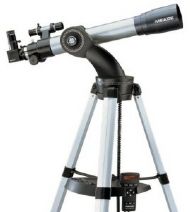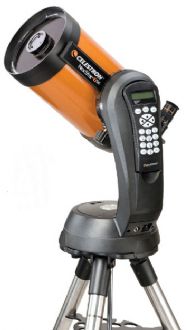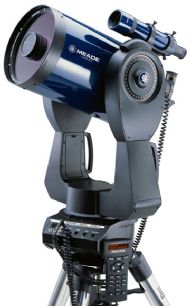 Cromarty Vortex | sitemap | log in Cromarty Vortex | sitemap | log in
|
 |
||
| This is a free Spanglefish 1 website. | ||
To GoTo or not to Go
When selecting a telescope, one of the decisions you will have to make is how you are going to find celestial objects to observe. A telescope on a manual mount will require that you move the telescope by hand or by using 'slew' buttons on a control pad to point the 'scope at any part of the night sky. GoTo telescopes have a computer built into the mount that stores the locations of thousands of objects, along with their co-ordinates and other information about them. Once the telescope is set up for a night of observing, the user simply punches into the control pad the name of the object they want to observe and the computer takes over, slewing the 'scope to point at the desired object. Or not, as the case may be. GoTo sounds ideal, and should give you more time observing objects But for a few hundred pounds more, say in a £600 system, you could get a tried and tested optical tube assembly mounted on a well-engineered, beefy GoTo fork mount, atop a sturdy 1.5" diameter tubular tripod. The difference? Night and day. With more money invested in the engineering the GoTo will be more accurate, the tracking more reliable, the mount sturdier and tougher, the optics a joy to use, even the accessories will be better by a magnitude or so! The downside is that it will be a little heavier than the cheapie, but that pays off with steadier views.
So if you can afford it, get the more expensive model with a tried and tested heritage, and buy from a reliable dedicated astronomical dealer. Just read the adverts section of Astronomy Now or Sky at Night magazines, and do some phoning around. Do NOT pop along to the local camera shop and impulse buy the one that's been in the window for the last three years... Do I have a GoTo telescope? No. I fell victim to the lure of 'cheap and easy' GoTo and tried to mount my TeleVue 85 Apo refractor on a Celestron SLT mount. The tube was too heavy for the mount, and the time it took me to set up the mount could have been used star-hopping my way to objects to view. The GoTo was not too accurate either, and I tired of the thing after a few months of sporadic use. I will probably get another GoTo mount in the future, but will make sure I get one of the more up-market ones, such as a Nexstar SE or similar model, which are much stronger, more accurate and easier to align. Finally, consider if you NEED GoTo or not. For a beginner, I'd advise
|    |
|
 | ||
 and less time spent trying to find them, but it's not that simple. If you are a beginner just starting out in the hobby, you probably don't want to spend a huge amount on a telescope in case you don't actually enjoy observing, and that can be the first time GoTo-purchaser's downfall. Many people opt for a sub-£200 (like the Meade DS2080 pictured here) telescope with 'magical' GoTo mount and a small sperture of 100mm or less, constructed of plastic and on a flimsy tripod. The GoTo will probably get the telescope close to a specified object, but if you're a beginner and don't know what you're looking for, how can you tell if you're miles away or only a few arc-seconds? If it's cheap, it won't be constructed from heavy-duty reliable components, so there will be backlash in the gears, error in the drive system, play in the connections and joints, etc, etc.
and less time spent trying to find them, but it's not that simple. If you are a beginner just starting out in the hobby, you probably don't want to spend a huge amount on a telescope in case you don't actually enjoy observing, and that can be the first time GoTo-purchaser's downfall. Many people opt for a sub-£200 (like the Meade DS2080 pictured here) telescope with 'magical' GoTo mount and a small sperture of 100mm or less, constructed of plastic and on a flimsy tripod. The GoTo will probably get the telescope close to a specified object, but if you're a beginner and don't know what you're looking for, how can you tell if you're miles away or only a few arc-seconds? If it's cheap, it won't be constructed from heavy-duty reliable components, so there will be backlash in the gears, error in the drive system, play in the connections and joints, etc, etc. At the mid to upper range you may even get GPS built in to make setting up the GoTo mount a piece of cake. The GPS module will simply scan for satellites and download the location and time of the telescope, then use that information to extrapolate the locations of all the celestial objects visible! In the cheapie model, you'd have to input the date, time, location etc manually using the keypad, then align on several (usually three) stars that the computer would specify (and which you would have to locate in the sky)! The Celestron Nexstar 6SE pictured to left is a good example, as are any of the Meake ETX PE range of Maksutovs.
At the mid to upper range you may even get GPS built in to make setting up the GoTo mount a piece of cake. The GPS module will simply scan for satellites and download the location and time of the telescope, then use that information to extrapolate the locations of all the celestial objects visible! In the cheapie model, you'd have to input the date, time, location etc manually using the keypad, then align on several (usually three) stars that the computer would specify (and which you would have to locate in the sky)! The Celestron Nexstar 6SE pictured to left is a good example, as are any of the Meake ETX PE range of Maksutovs. against it. Not only for the cost issue of buying a good reliable one, but also because part of the fun of asrtronomy is finding your way around the sky, and being able to turn your 'scope to a faint galaxy or nebula on any given night simply because you Know Where It Is! That's a very rewarding feeling. However, for showing non-observers things in a telescope, a GoTo system is very handy, as you can swing from object to object quickly and reliably and simply let them absorb the views, rather than watch you physically hunt the objects down. Would you rather watch someone playing a video game or play it yourself? Exactly. That's why big observatories have GoTo telescopes - like the Meade 14" LX200R here - it maximises viewing time at the eyepiece.
against it. Not only for the cost issue of buying a good reliable one, but also because part of the fun of asrtronomy is finding your way around the sky, and being able to turn your 'scope to a faint galaxy or nebula on any given night simply because you Know Where It Is! That's a very rewarding feeling. However, for showing non-observers things in a telescope, a GoTo system is very handy, as you can swing from object to object quickly and reliably and simply let them absorb the views, rather than watch you physically hunt the objects down. Would you rather watch someone playing a video game or play it yourself? Exactly. That's why big observatories have GoTo telescopes - like the Meade 14" LX200R here - it maximises viewing time at the eyepiece.